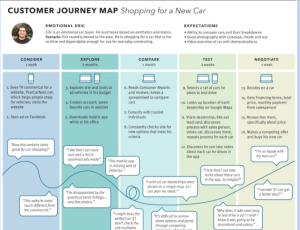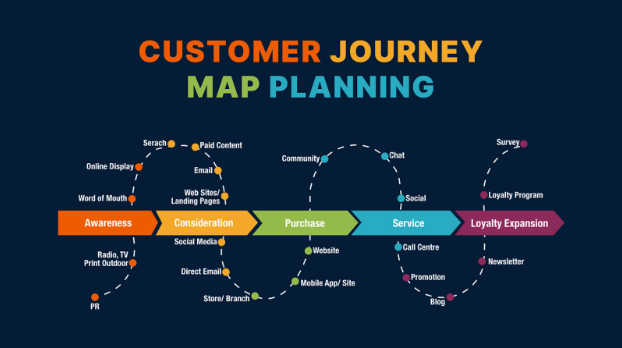In an era where digital presence is crucial, optimizing a landing page to align with your customer’s journey is pivotal for enhancing user experience and boosting conversion rates. Customer Journey Analytics on a landing page doesn’t just guide potential customers through a seamless conversion process; it also personalizes their experience, significantly increasing the chances of achieving your landing page’s objectives.
This blog explores the concept of integrating customer journey mapping into landing page design and how AI and technological advancements are making this integration more effective and insightful.
Understanding Customer Journey Mapping
Customer journey mapping is a visual representation of every experience your customers have with you. It helps in understanding the path taken by prospects from discovering your product to making a purchase decision. By applying this concept to a landing page, businesses can create a more focused and persuasive user experience that directly addresses the visitors’ needs and motivations at various stages of their journey.
Key Elements of Customer Journey Mapping for Landing Pages
Awareness and First Impression
Your landing page should immediately address the visitor’s initial query or need that brought them there. For example, if your AdWords campaign targets users looking for “fast home wifi solutions,” your landing page should prominently feature how your product solves this specific issue, ensuring the message is aligned with the user’s awareness stage.
Consideration and Evaluation
At this stage, visitors are comparing options. Incorporate elements that highlight your unique value proposition, such as customer testimonials, comparison charts, or even an AI-powered chatbot that provides personalized product recommendations based on the visitor’s specific needs.
Decision and Action

The bottom part of your landing page should facilitate decision-making. This includes a clear, compelling call-to-action (CTA), pricing information presented in an easy-to-understand format, and reassurances like money-back guarantees or free trials to mitigate perceived risks.
Incorporating AI and Technological Advancements
AI and technology play a crucial role in optimizing landing pages based on customer journey mapping.
AI-Driven Personalization
Leveraging AI to personalize the landing page experience can significantly enhance the customer journey. For instance, machine learning algorithms can analyze a visitor’s past interactions with your site to dynamically adjust the content, CTA, and offers presented, making them more relevant to the visitor’s stage in the journey.
Predictive Analytics for Customer Insights
Tools powered by AI offer predictive insights into customer behavior, allowing you to refine your landing page strategy continually. By understanding patterns and predicting future actions, you can tailor the customer journey on your landing page to match user expectations and increase conversion rates.
Chatbots for Real-Time Engagement
Integrating AI-powered chatbots on your landing page can guide visitors through their journey in real time. Chatbots can answer questions, provide recommendations, and even direct users to specific sections of the landing page, enhancing the overall user experience and supporting the decision-making process.
Best Practices for Implementing Customer Journey Mapping on Landing Pages
Segment Your Audience
Understand that different segments of your audience may have varying journeys. Consider creating multiple landing pages tailored to different segments or employing AI to dynamically serve content that matches each visitor’s journey stage.
Simplify the Navigation
The customer journey on your landing page should be intuitive and straightforward. Limit the number of options and ensure that each element on the page serves a purpose in guiding the visitor towards the desired action.
Optimize for Mobile
With the increasing prevalence of mobile browsing, ensure your landing page is optimized for mobile devices. A better way to ensure that is always look for having a app that you can create pretty easily with a Mobile app builder. This includes fast loading times, responsive design, and easily clickable elements, providing a seamless experience across all devices.
Conclusion: Enhancing Conversion through Customer Journey Mapping
Integrating customer journey mapping into your landing page design is not just about improving aesthetics or functionality—it’s about creating a thoughtful, persuasive pathway that aligns with your visitors’ needs and motivations.
By leveraging AI and technological advancements, businesses can personalize the landing page experience, offering real-time guidance and predictive insights to optimize each stage of the customer journey. As we move forward, the fusion of customer journey mapping with AI technology will undoubtedly become a cornerstone of effective landing page strategy, driving conversions and fostering customer loyalty.




